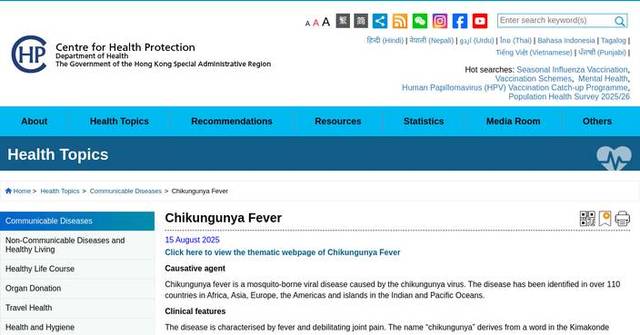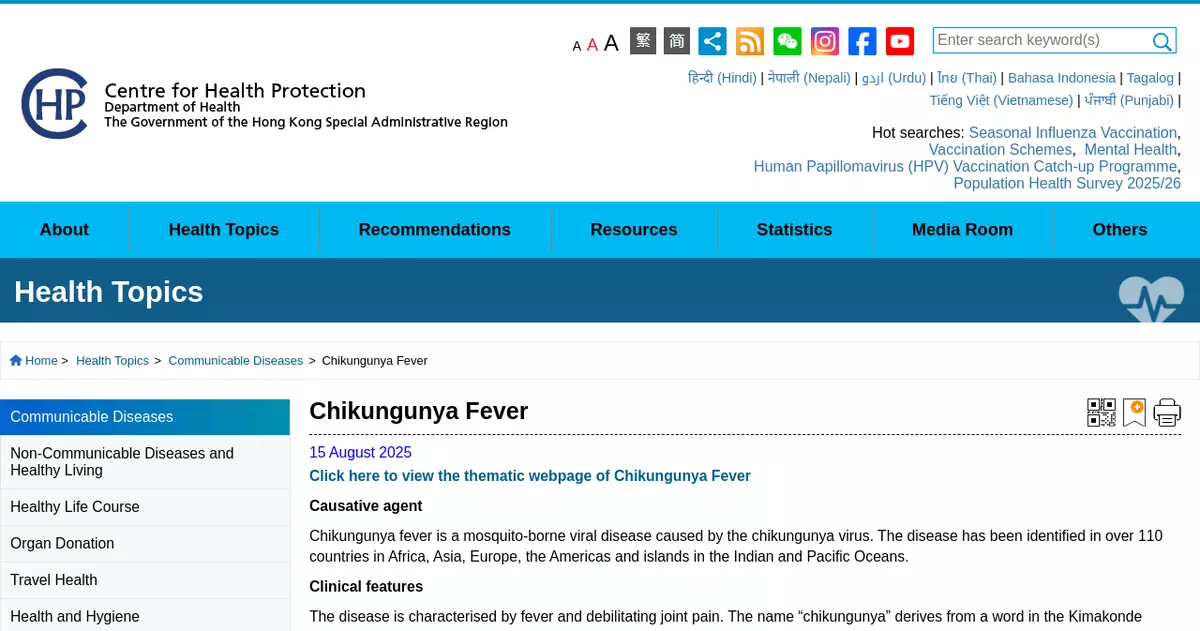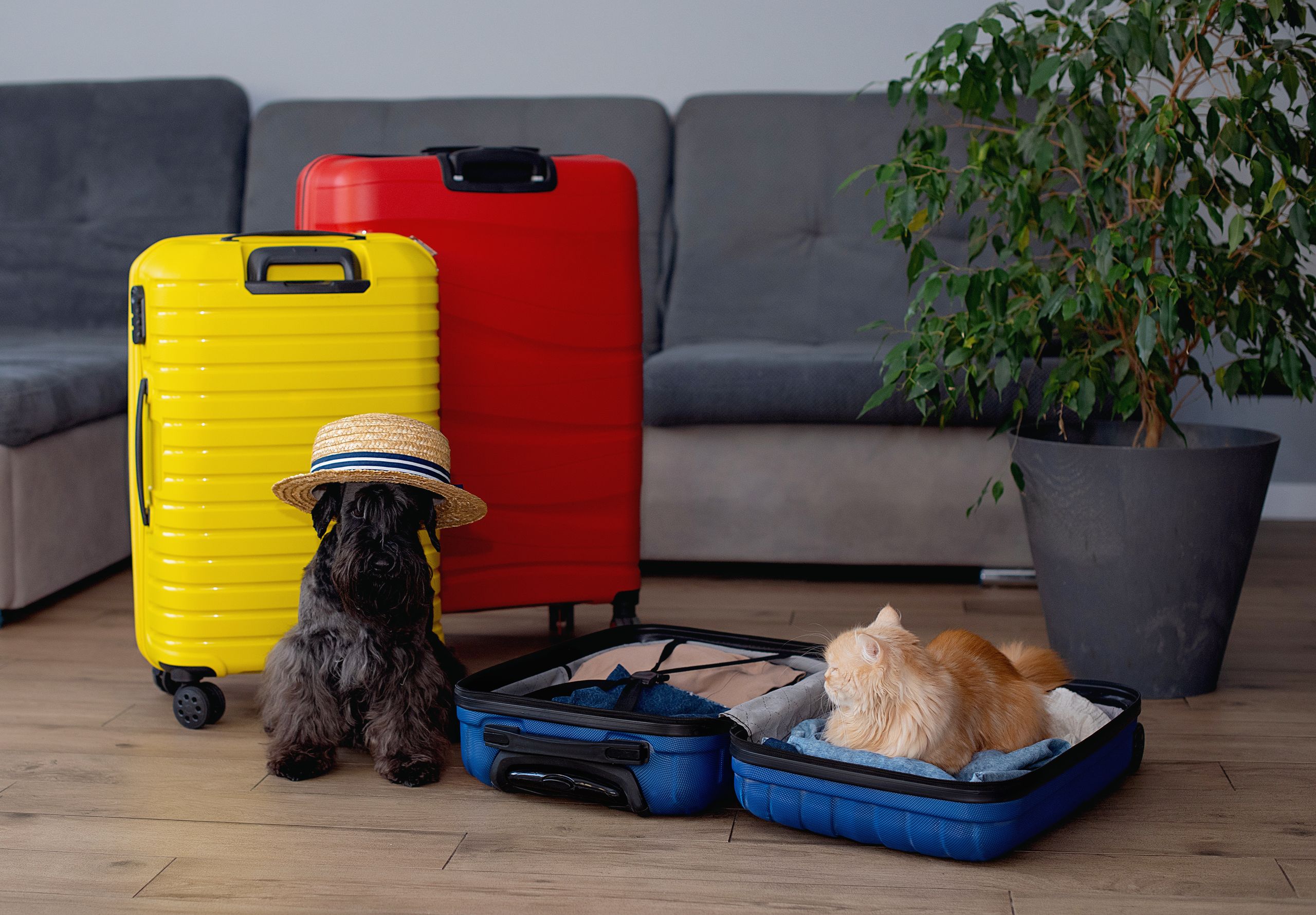Update on chikungunya fever
The Centre for Health Protection (CHP) of the Department of Health announced that as of 5pm today (October 15), three new cases of chikungunya fever (CF) had been recorded.
Latest cases information
The first case involves a 77-year-old male living in Eastern District. A preliminary investigation revealed that he visited Guangzhou in Guangdong between September 30 and October 13. He developed a fever and joint pain on October 13, and rash yesterday (October 14). He then sought medical attention at a private hospital. His household contact, who travelled with him to Guangzhou, is currently asymptomatic and under medical surveillance.
The second case involves a 34-year-old male living on Lantau Island. A preliminary investigation revealed that he travelled alone to Indonesia between October 2 and 4. He also travelled to Macao between October 6 and 7, and Shenzhen and Dongguan in Guangdong between October 10 and 12. He developed a fever, joint pain and rash on October 13. He sought medical attention at the Accident and Emergency Department of North Lantau Hospital yesterday. He has two household contacts. His travel companions included his relatives (including one household contact) and colleagues. All are currently asymptomatic and under medical surveillance.
The third case involves a 72-year-old male living alone in Central and Western District. A preliminary investigation revealed that he visited Foshan in Guangdong alone between October 4 and 12. He developed a fever and joint pain on October 13 and sought medical attention at the Accident and Emergency Department of Queen Mary Hospital yesterday.
All three males were admitted to the hospitals for treatment in a mosquito-free environment and are in stable condition. Their blood samples tested positive for the CF virus upon laboratory testing. Since they visited areas affected by CF during their incubation periods, the CHP considered that they were infected during travel. The cases were classified as imported. The CHP’s epidemiological investigations are ongoing, and it has reported the cases to relevant health authorities.
Latest surveillance data
So far this year, Hong Kong has recorded a total of 38 confirmed CF cases. All are imported cases. From 2016 to 2019, Hong Kong recorded between one and 11 imported cases annually.
Since the beginning of 2025, and as of September 30, a total of 445 271 suspected and confirmed CF cases and 155 CF-related deaths have been reported in 40 countries/territories. Cases have been reported in the Americas, Africa, Asia, and Europe. CF outbreaks currently occur in many countries worldwide. Members of the public should check the situation of the destinations before travelling abroad.
Continuously strengthening prevention and control
The Food and Environmental Hygiene Department (FEHD) continues to conduct vector investigations and targeted mosquito control operations, and intensify mosquito prevention and control measures at the residences of recently confirmed patients, as well as at locations visited after the onset of symptoms. These measures include:
The CHP urged schools to follow the FEHD’s anti-mosquito guidelines to strengthen efforts to clear stagnant water on school premises and eliminate mosquito breeding sites. It is also imperative to remind staff members and students to consistently implement mosquito prevention and personal protective measures to guard against the spread of mosquito-borne diseases within school premises.
Additionally, the CHP’s Port Health Division continues to step up inspections at boundary control points and remind cross-boundary public transport operators and other relevant parties to ensure good environmental hygiene and effective implementation of anti-mosquito measures. Furthermore, staff members of the Port Health Division distribute leaflets to travellers, conduct temperature screenings for inbound travellers, conduct health assessments for travellers with fever or related symptoms and refer them to hospitals for follow-ups when necessary.
Proper use of DEET-containing insect repellents or other effective active ingredients can prevent mosquito bites, but the following precautions should be taken when using them:
The FEHD also appeals to members of the public to continue to stay alert and work together to carry out mosquito prevention and control measures early, including inspecting their homes and surroundings to remove potential breeding grounds, changing water in vases and scrubbing their inner surfaces, removing water in saucers under potted plants at least once a week, and properly disposing of containers such as soft drink cans and lunch boxes. The FEHD also advises members of the public and estate management bodies to keep drains free of blockage and level all defective ground surfaces to prevent the accumulation of water. They should also scrub all drains and surface sewers with an alkaline detergent at least once a week to remove any mosquito eggs.
The public should call1823in case of mosquito problems, and may visit the following pages for more information: the CF page of theCHPand theTravel Health Service, the latestTravel Health News,tips for using insect repellents, and the CHPFacebook Page,Instagram AccountandYouTube Channel, and also theMosquito Prevention and Control dedicated pageof the FEHD.
Source: AI-found images
Government welcomes passage of Road Traffic (Amendment) (Ride-hailing Service) Bill 2025
The Government welcomed the passage of the Road Traffic (Amendment) (Ride-Hailing Service) Bill 2025 today (October 15), which marks a significant milestone in introducing a regulatory regime for ride-hailing services, providing the public with safer, more reliable, and diverse personalised point-to-point transport services.
The Road Traffic (Amendment) (Ride-hailing Service) Ordinance 2025 (the Ordinance) introduces a regulatory framework for ride-hailing services, requiring platforms, vehicles, and drivers providing ride-hailing services to obtain licences or permits. Platforms holding ride-hailing service licences must maintain proper and efficient services and conduct due diligence on their vehicles and drivers. Ride-hailing vehicles must meet various requirements, including holding appropriate third-party risk insurance, complying with the requirements on the age and inspection of vehicles, and being linked to the driver (i.e. the vehicle must be registered in the name of an individual and be driven by its registered owner to provide ride-hailing passenger services). Also, ride-hailing vehicle drivers must meet specified conditions, such as being at least 21 years old, having no serious traffic convictions within the past five years, and have passed a relevant test.
In addition to regulating ride-hailing services, the Ordinance also strengthens penalties and arrangements related to illegal carriage of passengers for reward. This includes specifying that convicted drivers should be disqualified from driving for not less than 12 months (and not more than three years), and strengthening arrangements for the temporary suspension of vehicle licences and vehicle impoundments, enabling enforcement agencies to impound vehicles involved, even if the driver involved cannot be identified for the purpose of instituting criminal proceedings, thereby further combating illegal carriage of passengers for reward.
The Secretary for Transport and Logistics, Ms Mable Chan, said, “The Government is determined to introduce a legal framework for regulating ride-hailing services. This will address the long-standing controversies surrounding such services and provide the public with more travel options that are safer and lawful, while promoting the modernisation and rejuvenation of the point-to-point transport trade, thereby achieving a win-win situation for the public, taxis and ride-hailing services.
“The Ordinance represents a crucial step forward in the Government’s legislative work. By first establishing the fundamental regulatory principles, it lays a solid legal foundation for establishing the technical details in the next stage. We will immediately proceed with the next stage of work, including discussing in a focused manner with stakeholders and finalising the regulatory details through subsidiary legislation and licence/permit conditions. We will continue to listen to the views and suggestions from all parties, with a view to adopting a ‘people-oriented and win-win’ approach,” she added.
The Ordinance will be gazetted on October 24. The Government plans to submit the subsidiary legislation detailing regulatory requirements to the Legislative Council for scrutiny in the first half of next year, with a view to completing the relevant legislative procedures in mid-2026. Subject to the preparatory work of the platforms that are granted ride-hailing service licences, it is expected that the licensed platforms may commence operations in the fourth quarter of next year.
Source: AI-found images




